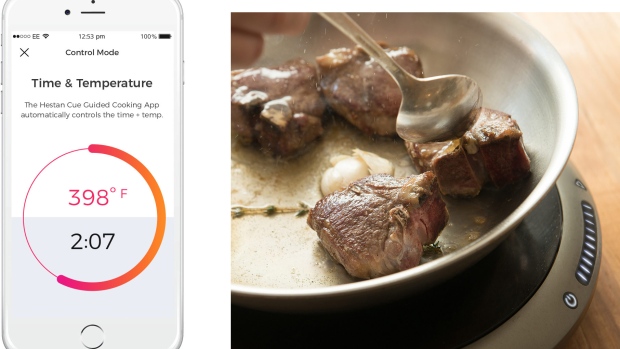Dec 1, 2017
Would you pay US$500 for a 'smart' skillet?
, Bloomberg News

When a recipe tells you to set your stove to “medium-high” heat, what exactly does that mean?
As someone who has read — and written — hundreds of recipes, I can say with some authority that nobody really knows. Since your stovetop does not have, say, a 400F setting, you must instead rely on primitive, vague instructions such as turning the dial to a spot one you hope is halfway from medium to high. Cranking the most powerful burner to that point on your beautiful ivory Aga Legacy, at 15,000 BTUs, will get you a good sizzle, but going that far on a US$15,000 Blue Star range that pumps out an infernal 25,000 BTUs per burner will give you a smoke-alarm-ripping sear.
Knowing and controlling the temperature of your stovetop the way you know and control that of your oven is one of the most obvious, useful improvements one can make in the kitchen. At least, that’s the promise of the US$499 Hestan Cue system, an app-controlled induction burner the size of a Roomba, with temperature-sensing pots and pans, included the newest addition, a chef’s pot, all connected to each other via Bluetooth.
Hestan is a part of the Meyer Corp., a Hong Kong-based manufacturer of kitchen equipment and parent of such brands as Farberware, Analon, and Silver Stone. The included 11-inch pan is solidly constructed and hefty, at a touch over three pounds. The 1600-watt induction burner takes up no more space than absolutely necessary, though the fan is a bit noisy.
Setup is about as complicated as hooking up a wireless speaker to your phone. The pan’s Bluetooth transmitter is a pinky-sized module that takes an (included) AAA battery and screws into the handle. The app walks you through pairing the phone with the pan and burner. While the process is seamless, it is also much more in the spirit of Steve Jobs than Escoffier. Unlike the recent fad for “smart” refrigerators, dishwashers, and juicers, the Hestan Cue is one of the few kitchen appliances that actually benefits from being connected to the Internet, to the extent that you’re using it for the app’s recipes.
The app at the centre of system is, after all, more than just a thermostat controller. It is a voluminous recipe bank with video demonstrations of crucial or confusing steps, and it automatically controls the burner. Most interesting is a mix-and-match option, in which you pair a protein (choices include skirt steak and salmon, sea scallops, and eggplant, though that’s not technically a protein) with a complementary sauce such as Thai green curry, bacon emulsion, and brandy-peach gastrique, to name a few. The app generates instructions on the fly.
Most recipes, whether for a citrus caramel sauce or a pan-seared flat iron steak, start with a short video introduction that gives a sense of what you’ll be shooting for. The ones I tested were all clearly written and demonstrated. For a crispy skin-duck dish, the automatic temperature control made all the difference on the burnt honey glaze, when the line between perfect and pan-ruiningly carbonized can be just a few seconds (or degrees).
Because the system reads the temperature of the pan and not what’s in it, ingredients need to conform pretty closely to the recipes’ specifications. For example, that duck recipe calls for two (or four, depending on the number of servings you select) seven-ounce duck breasts. In the course of the preparation, you are asked to select how you would like your duck cooked — medium rare, medium, or medium well. Then you are asked to measure and select the thickness of your raw duck breast, using a (included) steel ruler. Those two factors will determine the precise cooking time and temperatures for the duck. In my case, it was about 13 minutes, total. If, however, you have two different-sized duck breasts, they fall outside the automated thickness range, or you want one cooked to medium and the other medium rare, the system is ill-equipped to accommodate.
Should you lose the Internet connection between your pan and the app in the middle of cooking (as happened to me,) reestablishing a connection and resuming your cooking in flagrante requires a certain unflappability. That said, if you’re a tech-savvy novice cook happy to stay within the app-given guardrails, you’ll turn out impressive dishes and probably become a better cook in the process. If you’re already an expert cook and want a commercial-grade induction burner designed with precision temperature control — both for the pan and the food you’re cooking — consider the standard-setting US$1,799 Control Freak from Breville and Polyscience.
Both the Control Freak and the Hestan Cue have a distinct drawback: cleanup. Since either is likely to be on your countertop, not on your more easily cleaned stovetop surface — or for that matter, under your vent hood — smell and splatter will be less contained. Should that be an overriding concern, General Electric Co. (GE.N) offers an interesting product in its US$144 Precision Cooking Probe, compatible with Monogram and Cafe series induction cooktops. It fixes magnetically to any induction-compatible pot or pan and provides similar temperature-control functionality.
While we’re undeniably heading toward more precise temperature control in the kitchen, the timetable is as murky as ever. Gas ranges remain incredibly popular, and the habits gained from millennia of cooking over open flames are not likely to ease their grip anytime soon. But induction-cooking technology, which has been around since the beginning of the 20th century, is making inroads into home kitchens. Hestan is smart to bank on the idea that if you learn to cook using induction heat, it’ll set your appetite for a more precise way to cook on high.





